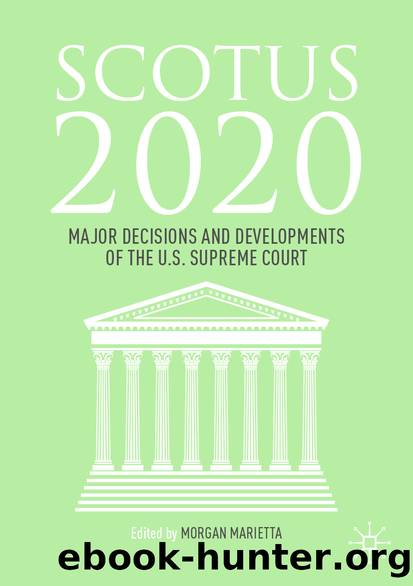SCOTUS 2020 by Unknown

Author:Unknown
Language: eng
Format: epub
ISBN: 9783030538514
Publisher: Springer International Publishing
The Dissents
There were four dissents in the case written by Justices Thomas, Alito, Gorsuch, and Kavanaugh. The longest dissent by far (34 pages) was written by Alito, who launched a broadside against the decision, writing that it âtwists the law.â In both Whole Womenâs Health and this decision, Alito wrote, âthe abortion right recognized in this Courtâs decisions is used like a bulldozer to flatten legal rules that stand in the way.â In particular, he argued that doctors who provide abortions are interested in making money and avoiding regulations whereas women seeking abortions are interested in their safety. This âblatant conflict of interestâ precluded the doctors from asserting the rights of women wishing to obtain an abortion as the basis of their standing. â[I]t is deeply offensive to our rules of standing,â Alito wrote, âto permit them to sue in the name of their patients when they challenge laws enacted to protect their patientsâ safety.â26
Alito also argued that the plurality misapplied the undue burden standard by balancing the benefits of the law against the burden created. The correct constitutional standard, he argued, was âCaseyâs âsubstantial obstacleâ test, not the Whole Womanâs Health balancing test,â and hence Whole Womanâs Health should be overruled.27
Like Breyerâs opinion, Alitoâs dissent was heavily fact-based. In his view, the opinion of the federal district judge striking down the law was based on a âthoroughly inadequate factual inquiry.â Alito found âample evidence in the record showing that requiring admitting privileges has health and safety benefits.â28 In Alitoâs view, such factual determinations are best left to legislatures, not courts.
As for the issue of precedent, Alito found the two cases âvery different.â Admitting that it is âcertainly true that the Texas and Louisiana statutes are largely the same,â Alito maintained that the âtwo cases are not.â29 This was because of factual differences between Texas and Louisiana that Judge deGravelles failed to examine. Thus, the holding in Whole Womanâs Health didnât require the Court to invalidate the Louisiana law.
Justice Thomas agreed with all of Alitoâs criticisms. He wrote separately for two reasons. First, he would have dismissed the case for lack of standing. Second, Thomas emphasized that there was no constitutional right to abortion. He concluded his dissent on these two points: âBecause we lack jurisdiction and our abortion jurisprudence finds no basis in the Constitution, I respectfully dissent.â30
Justice Gorsuch also wrote a dissent. Like Alito and Thomas, he objected to the granting of standing to the doctors. In addition to misapplying the Courtâs third-party standing rules, Gorsuch also argued that the Court violated other long-standing practices such as legislative deference. Like Alito, Gorsuch emphasized that the plurality assumed Whole Womanâs Healthâs âfact-laden predictions about how a Texas law would impact the availability of abortion in that State in 2016 ⦠obviously and necessarily applied to Louisiana in 2020.â In particular, he wrote that the plurality took a âremarkably static view of the marketâ that took no account of how hospitals might change their rules to offer admitting privileges, new
Download
This site does not store any files on its server. We only index and link to content provided by other sites. Please contact the content providers to delete copyright contents if any and email us, we'll remove relevant links or contents immediately.
The Lost Art of Listening by Michael P. Nichols(7179)
Why I Am Not A Calvinist by Dr. Peter S. Ruckman(4052)
The Rosicrucians by Christopher McIntosh(3378)
Wicca: a guide for the solitary practitioner by Scott Cunningham(3048)
Signature in the Cell: DNA and the Evidence for Intelligent Design by Stephen C. Meyer(2882)
Real Sex by Lauren F. Winner(2876)
The Holy Spirit by Billy Graham(2784)
To Light a Sacred Flame by Silver RavenWolf(2684)
The End of Faith by Sam Harris(2637)
The Gnostic Gospels by Pagels Elaine(2407)
Waking Up by Sam Harris(2337)
Nine Parts of Desire by Geraldine Brooks(2285)
Jesus by Paul Johnson(2232)
Devil, The by Almond Philip C(2213)
The God delusion by Richard Dawkins(2195)
Heavens on Earth by Michael Shermer(2194)
Kundalini by Gopi Krishna(2094)
Chosen by God by R. C. Sproul(2058)
The Nature of Consciousness by Rupert Spira(1983)
